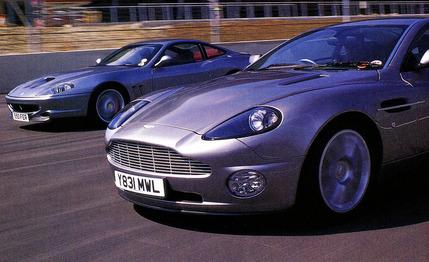
 Comparison Tests
Comparison Tests


Technical editor Larry Webster's e-mail summed up what was in store for us. "Wow. Driving an Aston Martin Vanquish and Ferrari Maranello around England. Does it get any better than that?"
It doesn't. Connoisseurs of the grand-touring car know that this rather old-fashioned idea finds its finest expression in Maranello, Italy, and in Newport Pagnell, England. Ferrari versus Aston Martin: exotic conveyances for the rich and famous that once fought it out on the racetracks.
The Aston Martin V-12 Vanquish is the latest contender in the GT stakes. Available for a shuddering $235,600, it is the most expensive car in the ever-widening Ford empire. And it's the most exclusive. The boutique of Ford's Premier Automotive Group (the name given to its corral of luxury cars) plans to make just 300 examples of the Vanquish at Newport Pagnell each year, and a third of those are destined for the U.S.
Aston people never mention Ferrari, preferring the Vanquish to be seen as a modern, high-tech successor to its archaic "V" cars — big, heavy, handcrafted models that could trace a lineage back to the race-bred Astons of the 1960s. But the truth is the Vanquish has only one direct competitor in its exalted price class, and that is the Ferrari 550 Maranello.
In 1996, Ferrari, which is owned by Fiat, shocked supercar fans by introducing the 550 model as a front-engined two-seater. For a quarter of a century its roadgoing flagships had followed racing practice by putting the engine behind the driver. Now Ferrari, it seemed, was picking up where the 365GTB/4 Daytona left off in 1971.
Ferrari president Luca di Montezemolo said that owners of its 12-cylinder models were fed up with a reclining seating position behind a steeply inclined windshield, poor visibility, and a lack of luggage space. The 550, it was noted, would be faster, easier, and more practical to use and have better handling at its limits than the mid-engined F512M that it replaced.
And so it was. Surprisingly few mourned the passing of the Testarossa/512. And anyway, today's smaller and lighter mid-engined 360 Modena is almost as fast. The 550 Maranello became the new benchmark for the grown-up exotics, and Car and Driver's editor-in-chief proved its serious performance with a series of production-car speed records, including an average of 190.132 mph over a 100-mile distance (February 1999).
Aston Martin, which had suffered from underinvestment and constant changes of ownership before Ford purchased 75 percent of the British company in 1987, had never made the transition to mid-engined road cars. But then neither had it been any kind of leader in technology. The Vanquish is a major step forward, with a specification that makes the 550 look staid and traditional: a super-stiff chassis of bonded aluminum with a carbon-fiber backbone and windshield pillars, body panels of "superformed" aluminum (they're first heated and then molded over bucks by air pressure), and sophisticated electronics that include the direction of the clutch and six-speed manual gearbox to give the Vanquish a Formula 1-style paddle-shifting manumatic transmission.
In power and performance, there is not much difference, on paper, between the Vanquish and the 550 Maranello. Both have large-displacement V-12 engines and six-speed gearboxes. The cars are close in size, although the Ferrari is a touch shorter, lower, and wider. Aston's engineers have lapped the speed bowl at the Nardo proving ground in Italy at more than 190 mph.
Our journey in these exotics led through middle England to the GM-owned Millbrook proving ground near Bedford for instrumented performance testing and to Britain's newest auto-racing attraction, the NASCAR-style Rockingham Motor Speedway near Corby in Northamptonshire, which was being prepared for the visit of the FedEx Champ Cars in September. Neither had straights long enough to run these cars flat-out. But we were able to run on Rockingham's intriguingly asymmetrical banked oval and twisting infield road course.
We drove the cars on wide-open roads with fast sweepers through flat terrain, over sinuous, bumpy lanes up hill and down dale that tax stability and brakes and tell you plenty about the cars' ride quality, and on freeways that are too crowded and monitored for very high speeds but perfect for assessing these cars' suitability in normal use. As fast and exciting as they are, these are usable daily rides. For once, though, a Ferrari was cast in the unaccustomed role of the conservative and conventional player against the more modern and adventurous Aston. For our decision and the whys and wherefores, read on.